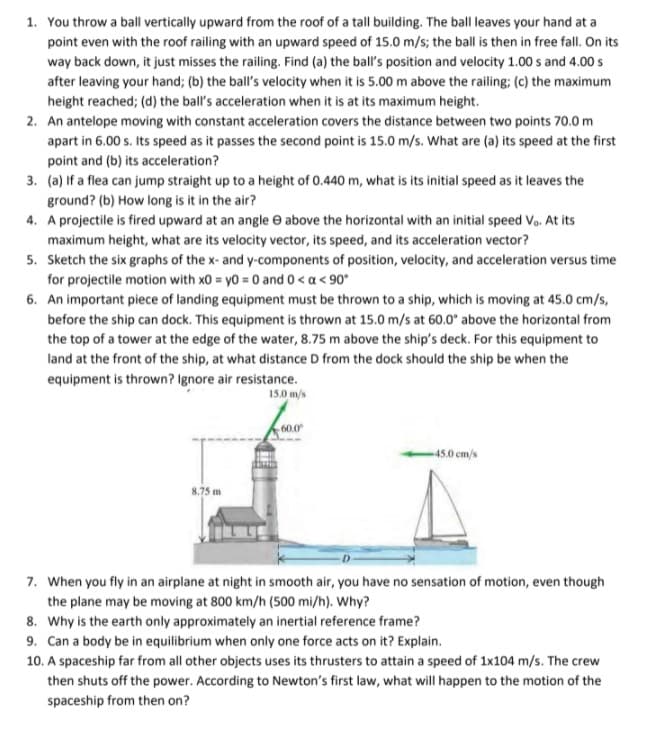When you fly in an airplane at night in smooth air, you have no sensation of motion, even though the plane may be moving at 800 km/h (500 mi/h). Why?
When you fly in an airplane at night in smooth air, you have no sensation of motion, even though the plane may be moving at 800 km/h (500 mi/h). Why?
Physics for Scientists and Engineers, Technology Update (No access codes included)
9th Edition
ISBN:9781305116399
Author:Raymond A. Serway, John W. Jewett
Publisher:Raymond A. Serway, John W. Jewett
Chapter4: Motion In Two Dimensions
Section: Chapter Questions
Problem 4.75AP: A World War II bomber flies horizontally over level terrain with a speed of 275 m/s relative to the...
Related questions
Question
When you fly in an airplane at night in smooth air, you have no sensation of motion, even though
the plane may be moving at 800 km/h (500 mi/h). Why?

Transcribed Image Text:1. You throw a ball vertically upward from the roof of a tall building. The ball leaves your hand at a
point even with the roof railing with an upward speed of 15.0 m/s; the ball is then in free fall. On its
way back down, it just misses the railing. Find (a) the ball's position and velocity 1.00 s and 4.00 s
after leaving your hand; (b) the ball's velocity when it is 5.00 m above the railing; (c) the maximum
height reached; (d) the ball's acceleration when it is at its maximum height.
2. An antelope moving with constant acceleration covers the distance between two points 70.0 m
apart in 6.00 s. Its speed as it passes the second point is 15.0 m/s. What are (a) its speed at the first
point and (b) its acceleration?
3. (a) If a flea can jump straight up to a height of 0.440 m, what is its initial speed as it leaves the
ground? (b) How long is it in the air?
4. A projectile is fired upward at an angle e above the horizontal with an initial speed Vo. At its
maximum height, what are its velocity vector, its speed, and its acceleration vector?
5. Sketch the six graphs of the x- and y-components of position, velocity, and acceleration versus time
for projectile motion with x0 = y0 = 0 and 0 < a< 90°
6. An important piece of landing equipment must be thrown to a ship, which is moving at 45.0 cm/s,
before the ship can dock. This equipment is thrown at 15.0 m/s at 60.0° above the horizontal from
the top of a tower at the edge of the water, 8.75 m above the ship's deck. For this equipment to
land at the front of the ship, at what distance D from the dock should the ship be when the
equipment is thrown? Ignore air resistance.
15.0 m/s
60.0
45.0 cm/s
8.75 m
7. When you fly in an airplane at night in smooth air, you have no sensation of motion, even though
the plane may be moving at 800 km/h (500 mi/h). Why?
8. Why is the earth only approximately an inertial reference frame?
9. Can a body be in equilibrium when only one force acts on it? Explain.
10. A spaceship far from all other objects uses its thrusters to attain a speed of 1x104 m/s. The crew
then shuts off the power. According to Newton's first law, what will happen to the motion of the
spaceship from then on?
Expert Solution
This question has been solved!
Explore an expertly crafted, step-by-step solution for a thorough understanding of key concepts.
Step by step
Solved in 2 steps

Knowledge Booster
Learn more about
Need a deep-dive on the concept behind this application? Look no further. Learn more about this topic, physics and related others by exploring similar questions and additional content below.Recommended textbooks for you

Physics for Scientists and Engineers, Technology …
Physics
ISBN:
9781305116399
Author:
Raymond A. Serway, John W. Jewett
Publisher:
Cengage Learning

Physics for Scientists and Engineers with Modern …
Physics
ISBN:
9781337553292
Author:
Raymond A. Serway, John W. Jewett
Publisher:
Cengage Learning

Physics for Scientists and Engineers
Physics
ISBN:
9781337553278
Author:
Raymond A. Serway, John W. Jewett
Publisher:
Cengage Learning

Physics for Scientists and Engineers, Technology …
Physics
ISBN:
9781305116399
Author:
Raymond A. Serway, John W. Jewett
Publisher:
Cengage Learning

Physics for Scientists and Engineers with Modern …
Physics
ISBN:
9781337553292
Author:
Raymond A. Serway, John W. Jewett
Publisher:
Cengage Learning

Physics for Scientists and Engineers
Physics
ISBN:
9781337553278
Author:
Raymond A. Serway, John W. Jewett
Publisher:
Cengage Learning

College Physics
Physics
ISBN:
9781305952300
Author:
Raymond A. Serway, Chris Vuille
Publisher:
Cengage Learning

College Physics
Physics
ISBN:
9781285737027
Author:
Raymond A. Serway, Chris Vuille
Publisher:
Cengage Learning

Principles of Physics: A Calculus-Based Text
Physics
ISBN:
9781133104261
Author:
Raymond A. Serway, John W. Jewett
Publisher:
Cengage Learning